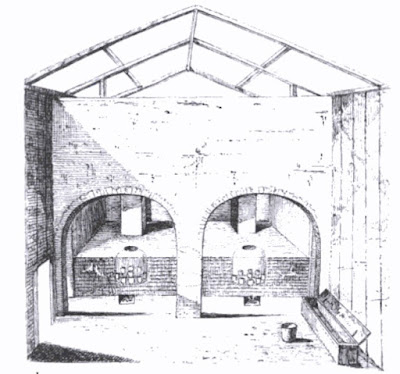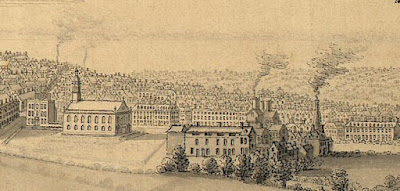 |
| Interior Mr. Turner's Brass Works from R. R. Angerstein's Illustrated Travel Diary, 1753-1755. |
Reinhold Rücker Angerstein was a Swedish metallurgist from a family of iron masters, who extensively travelled Britain's industrial works in the early 1750s, including many in Birmingham and nearby. In 1754 he visited Turner's brass works in Birmingham:
The brass-works [...] belongs to Mr Turner and consists of nine furnaces with three built together in each of three separate buildings. The furnaces are heated with mineral coal, of which 15 tons is used for each furnace, and melting lasting ten hours. Each furnace holds nine pots, 14 inches high and nine inches diameter at the top. Each pot is charged with 41 pounds of copper and 50 pounds of calamine. Mixed with [char]coal. During charging I observed that a handful of coal and calamine was first placed on the bottom of the pot, then came the mixture, which was packed in tightly, followed by about a pound of copper in small pieces, and finally again coal and calamine without copper, covering the top. This procedure was said to lengthen the life of the pot both at the top and the bottom. [...] There are six workers for the nine furnaces and casting takes place twice every 24 hours.*1*
In 1782, William Hutton stated that the 'manufacture of brass was introduced by the family of Turner, about 1740, who erected those works at the south end of Coleshill-street' (see map, below). Although writing in 1783, Hutton first visited Birmingham in the 1740s and moved to the town in 1750, so would have some recollection of the early brass trade. He also said of the works that 'Under the black clouds which arose from this corpulent tunnel, some of the trades collected their daily supply of brass'.*2* Those 'black clouds' can be seen rising from the chimney's of Turner's 'Brass Works' on the 1753 East Prospect of Birmingham:
 |
| St. Bartholomew's Chapel and smoking chimneys of the brass works, from the East Prospect of Birmingham (1753). |
 |
| Section of the 1751 Map of Birmingham showing Coleshill Street and Turner's Brass House. |
Although this was the beginnings of the manufacture of brass in Birmingham, Birmingham and nearby areas were already making brass things but buying brass produced elsewhere, such as Bristol. Buckles were one such brass thing, and Robert Plot noted the manufacture of 'Poland buckle[s], the pease buckle, chased buckles, Dutch and Irish buckles, which are brass' in Walsall in 1686.*3* John Wilkes was also making beautiful and intricate brass locks in Birmingham in the late 1600s (see post here). The opening of Turner's brass works meant that local makers could now source their brass in Birmingham.
The 'Mr Turner' noted by Angerstein was Thomas Turner.*4* It is possible that Thomas had made buckles before opening his brass-making works on Coleshill Street, as there was definitely a buckle maker called Thomas Turner working in Birmingham in the 1730s.*5*
The 'Mr Turner' noted by Angerstein was Thomas Turner.*4* It is possible that Thomas had made buckles before opening his brass-making works on Coleshill Street, as there was definitely a buckle maker called Thomas Turner working in Birmingham in the 1730s.*5*
In the 1770 Birmingham Directory John and William Turner were 'Proprietors of the Brass Works' at 4 Coleshill Street, possibly sons, or other relatives, of Thomas. William Turner's marriage licence described him as a brass maker.*6*
NOTES
*1* R. R. Angersteins Illustrated Travel Diary: Industry in England and Wales from a Swedish Perspective, 1753-1755, ed. and translated by Torsten and Peter Berg (London: Cromwell Press, 2001), pp. 38-39.*2* William Hutton, An History of Birmingham (Birmingham: Pearson and Rollason, 1783), p. 329.
*3* Robert Plot, The Natural History of Staffordshire (Oxford: The Theatre, 1686), p. 377.
*4* John Townley, 'Turner’s Brass House, Coleshill Street', published online on The Iron Room.
*5* Turner v Fulwood, 1738, National Archives, C 11/861/79.
*6* Staffordshire, Dioceses Of Lichfield & Coventry Marriage Allegations And Bonds, 1636-1893.
~ https://historywm.com/file/historywm/business-men-and-the-politics-of-the-brass-industry-article-duncan-frankis-final-28482.pdf
